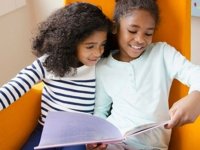The 3 E’s of Literacy: Strategies to Nurture A Love of Reading
Editor's note:This post was coauthored by Philomena Jones, a Big Thought Fellow with a focus on literacy development and arts education. Her background is business writing, recruiting and K-college public and private education.
Bookworms everywhere mourned the state of our country when Pew released a poll that found 23 percent of Americans didn't read a single book in the previous year. Things aren't looking particularly encouraging for future generations, either. Experts estimate that only 1/3 of parents regularly read to their children, even though reading plays an immense role in cognitive development.
Despite these depressing statistics, there is reason to take heart. With a greater emphasis on literacy research and advocacy, teachers have more information than ever about how to best cultivate a love for literacy in the classroom. There are numerous methods, but most fall under "the three E's of literacy."
1. Environment
As a student, I suffered from acute red-face-itis. For those unfamiliar with this tragic and debilitating disease, any focused or unexpected attention causes the face to light up like Rudolph's nose. As a result, the "popcorn" reading time (where the instructor randomly calls on students to read a passage) was practically waterboarding to my eight-year-old self. Reading aloud is an important thing to practice, but it doesn't have to be humiliating.
Long ago, students bonded over learning limericks, tongue twisters, jump rope rhymes and other interactions that reinforce literacy activities. Learning poems or passages together, in small groups or as a class, allows shy students to break out of their shells by providing the safety of practicing aloud within a larger group. Through reading together out loud, supportive scaffolding and modeling naturally occurs, and this process not only builds skills, but also provides children with a positive memory of reading. Students can (and will) take the memorization out of the classroom and practice with friends and parents, showing off their newfound party skill at all the fashionable recess soirées.
Though memorization has fallen out of favor in the classroom, it is a powerful skill for understanding, learning and building confidence with language in a fun way. The activities and environments that surround reading can be equally important in converting kids into lifelong readers.
2. Engagement
This brings us to our second E, engagement, which is the educational equivalent of the unicorn these days. With reading, engaging children means letting go of some of our adult/educator instincts and allowing children wide literary entryways. Researchers have found that the complexity of a book does not correspond to the benefits a child reaps from it. In fact, simple books can help teach basic principles like story structure.
It's tempting to turn up our nose at something fun yet relatively light, like Percy Jackson, but these types of books are invaluable. Kids can indulge their natural inclinations while becoming fluent in the art of reading and creating a habit of literacy. But there's more that you can do to help.
Think of children's reading appetite much like their appetite for food. Sure, they will reach for the chicken nuggets and French fries, but if they are regularly given hummus or sushi or pho or tortas, kids will begin to expand their tastes.
As a teacher, you can help them along by making connections to higher-level literature. The Percy Jackson series, for example, is a great example of lighter books that can connect to lessons about geography and history, and introduce literary devices like archetype and allegory. It also pairs well with Ovid's Metamorphoses, or one of Edith Hamilton's works. When you make explicit connections, students will begin to understand how to discover new books, not just how to read.
3. Example
Being an exemplar reader implies two sets of responsibilities for you as an educator. The first is to position yourself as a reader in the eyes of your students. You needn't go around with your nose in a book. Sprinkle your conversation with references to your favorite books or authors. Keep books on your desk. Write quotes from books on the board. Tell stories about why you loved reading as a kid, and why you love it now. Have real conversations with kids about the texts. You're a walking testimonial for literacy, helping kids to understand that being an adult doesn't mean the end of reading for business or pleasure, just the continuation of a lifelong series of opportunities.
The other way to set a standard of reading for children is to take advantage of any opportunity within your school or city where adults read to children. Many education nonprofits connect adults with opportunities to read to children and provide reading material through book giveaways and community partnerships such as Little Free Library. The library system is also a great resource that usually has weekly or monthly reading events where kids can listen to parents or other adults. Even if your city doesn't have a wealth of opportunities available, you can find many ways to read and share stories with children.
Seeing adults reading does more than set an example. It's priceless when children hear you model inflection and intonation (prosody), work to correlate pictures with words, see you correct yourself on pronunciation or phrasing, pick up on variations in cadence and tone, and absorb nuanced communication through the spoken word.
Ask any reader about their love of reading, and I guarantee that they will cite their personal experiences with a parent, teacher or another adult as a catalyst of their fondness for the written word.
